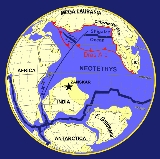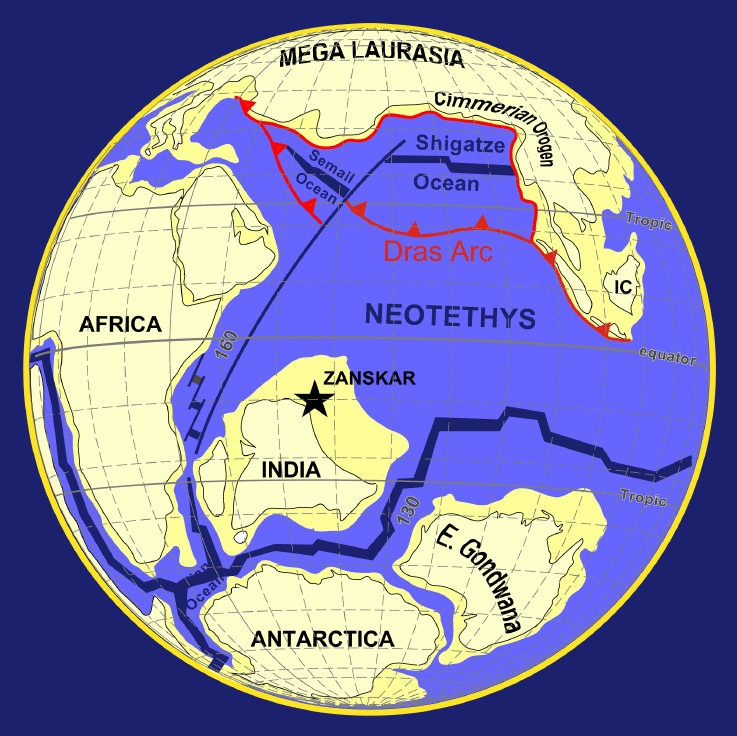
Cimmerian Orogeny
Encyclopedia

Orogeny
Orogeny refers to forces and events leading to a severe structural deformation of the Earth's crust due to the engagement of tectonic plates. Response to such engagement results in the formation of long tracts of highly deformed rock called orogens or orogenic belts...
that created mountain ranges that now lie in Central Asia. The orogeny is believed to have begun 200 - 150 million years ago (much of the Jurassic
Jurassic
The Jurassic is a geologic period and system that extends from about Mya to Mya, that is, from the end of the Triassic to the beginning of the Cretaceous. The Jurassic constitutes the middle period of the Mesozoic era, also known as the age of reptiles. The start of the period is marked by...
Period), when the Cimmerian plate
Cimmeria (continent)
Cimmeria was an ancient microcontinent that existed about 200 million years ago. It rifted north from Gondwana during the Late Carboniferous and collided against eastern Laurasia during the Late Triassic together with the Chinese continents. The collision created new mountain ranges between...
collided with the southern coast of Kazakhstania
Kazakhstania
Kazakhstania, also known as the Kazakhstan Block, is a small continental region in the interior of Asia. It consists of that area north and east of the Aral Sea, south of the Siberian craton and west of the Altai Mountains and Lake Balkhash. Politically, it comprises most of Kazakhstan and has a...
and North and South China
South China (continent)
South China continent, also known as South China craton, South Chinese craton, or Yangtze craton, was an ancient continent that contained today's South and Southeast China , Indochina, and parts of Southeast Asia...
, closing the ancient Paleo-Tethys Ocean
Paleo-Tethys Ocean
The Paleo-Tethys Ocean was an ancient Paleozoic ocean. It was located between the paleocontinent Gondwana and the so called Hunic terranes. These are divided into the European Hunic and Asiatic Hunic...
between them. The plate consisted of what are now known as Turkey
Turkey
Turkey , known officially as the Republic of Turkey , is a Eurasian country located in Western Asia and in East Thrace in Southeastern Europe...
, Iran
Iran
Iran , officially the Islamic Republic of Iran , is a country in Southern and Western Asia. The name "Iran" has been in use natively since the Sassanian era and came into use internationally in 1935, before which the country was known to the Western world as Persia...
, Tibet
Tibet
Tibet is a plateau region in Asia, north-east of the Himalayas. It is the traditional homeland of the Tibetan people as well as some other ethnic groups such as Monpas, Qiang, and Lhobas, and is now also inhabited by considerable numbers of Han and Hui people...
and western Southeast Asia
Southeast Asia
Southeast Asia, South-East Asia, South East Asia or Southeastern Asia is a subregion of Asia, consisting of the countries that are geographically south of China, east of India, west of New Guinea and north of Australia. The region lies on the intersection of geological plates, with heavy seismic...
. Much of the plate's northern boundary formed mountain ranges that were as high as the present-day Himalayas. The orogeny continued well into the Cretaceous
Cretaceous
The Cretaceous , derived from the Latin "creta" , usually abbreviated K for its German translation Kreide , is a geologic period and system from circa to million years ago. In the geologic timescale, the Cretaceous follows the Jurassic period and is followed by the Paleogene period of the...
and Early Cenozoic
Cenozoic
The Cenozoic era is the current and most recent of the three Phanerozoic geological eras and covers the period from 65.5 mya to the present. The era began in the wake of the Cretaceous–Tertiary extinction event at the end of the Cretaceous that saw the demise of the last non-avian dinosaurs and...
.
See also
- Hercynian orogeny - an orogeny that preceded the Cimmerian orogeny
- Alpine orogenyAlpine orogenyThe Alpine orogeny is an orogenic phase in the Late Mesozoic and Tertiary that formed the mountain ranges of the Alpide belt...
- an orogeny that succeeded the Cimmerian orogeny

